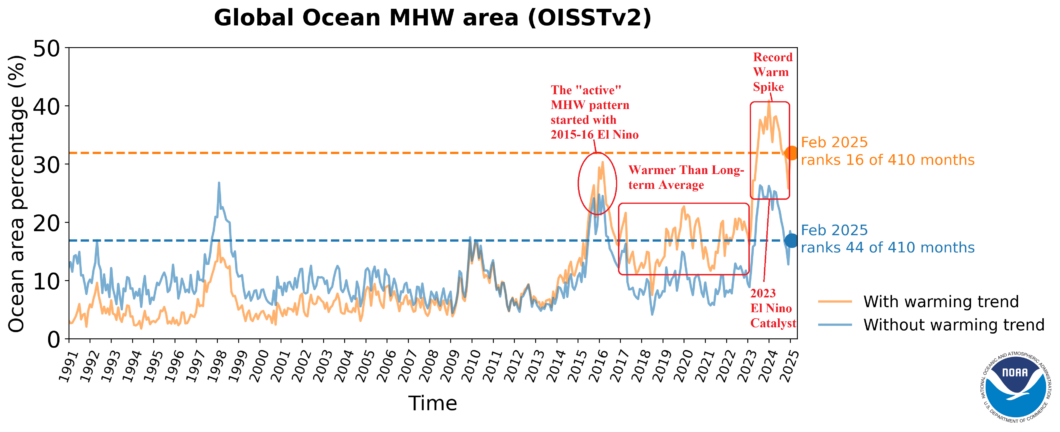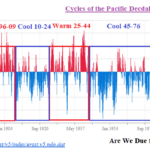
Are We Due for a Cycle Change of the Pacific Decadal Oscillation?
04/10/2025, 7:49 pm EDT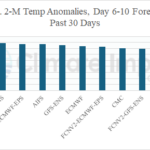
AI/Operational Models Spot Check Verification
04/19/2025, 2:47 pm EDTExecutive summary: Climate Impact Company monitors marine heatwaves (MHW) due to their recent (past 10 years) increased presence and intensity and influence on climate patterns. Generally, anomalous high pressure extends across and downwind MHW regions, promoting drought risk while also adding low-level moisture to the atmosphere to cause over-achieving precipitation events and intensifying tropical cyclones. MHW’s add intensity to the character of the climate change era which, on average, have the tendency to produce long-term (drought) regimes occasionally interrupted by short-term extreme weather (excessive precipitation) events.

Fig. 1: Global oceans affected by marine heatwaves 1991-2025.
Discussion: Global SSTA remain much above normal averaging second warmest on record for each month of 2025 so far according to the Australia Bureau of Meteorology. Last year was warmest on record. A significant contribution to the oceanic warming is the presence of marine heatwaves (MHW). MHW warming has become obvious beginning with the 2015-16 El Nino with a second stronger warming spike following the 2023 El Nino (Fig. 1). In-between El Nino events, oceanic warming influence from MHW’s stayed well above the long-term average.
MHW’s have a tendency for strongest signature during late or just after the summer season. Currently, in the southern hemisphere, many MHW’s stretch across the subtropical and mid-latitude oceans, strongest surrounding Australia and Madagascar (Fig. 2). During recent years, MHW’s have easily maintained their identity during meteorological winter and entering the spring season as MHW’s linger in the northern hemisphere after their robust peak intensity during Q3/2024.
The 30-day SSTA trend in the northern hemisphere reveals warming beginning to regenerate east of Japan and west-southwest of California while weakening in the Mediterranean Sea and west-southwest of Europe (Fig. 3). In the southern hemisphere, recent warming is robust off the south and southeast coast of Africa while waters surrounding Australia have cooled slightly. The MHW off the Argentina Coast has a split personality with cooling in the northern zone and warming in the southern zone.
The global MHW outlook for June 2025 reveals significant intensification of the northwest Pacific basin MHW expanding eastward to east of the Dateline while MHW NEP24A west-southwest of California also intensifies but stays offshore (Fig. 4). The North Atlantic basin has cooled significantly since last year. While the tropics are expected to remain close to normal, the central North Atlantic basin MHW regenerates and strengthens during summer 2025. Recent significant cooling in the Mediterranean Sea and Black Sea suggest the indicated rewarming by June may be too aggressive. The MHW forecast on the Northwest Eurasia Coast is also too aggressive.
By September, when the northern hemisphere MHW’s (typically) reach peak intensity, the non-tropical Pacific basin is extremely warm lead by the northwest/north-central basin MHW and NEP24A (Fig. 5). The central North Atlantic basin MHW is steadily very warm. Note the North Atlantic warm hole (NAWH) is steadily apparent south of Greenland all summer. In the southern hemisphere, MHW’s surrounding Australia and east of Argentina continue in September.
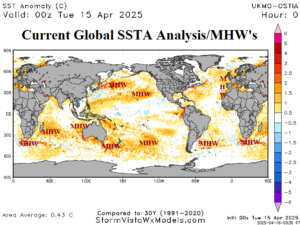
Fig. 2: Daily global SSTA analysis reveals where MHW’s are located.

Fig. 3: Daily global 30-day SSTA change analysis.

Fig. 4: NOAA global MHW forecast valid June 2025.
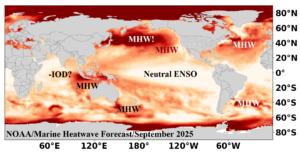
Fig. 5: NOAA global MHW forecast valid September 2025.

